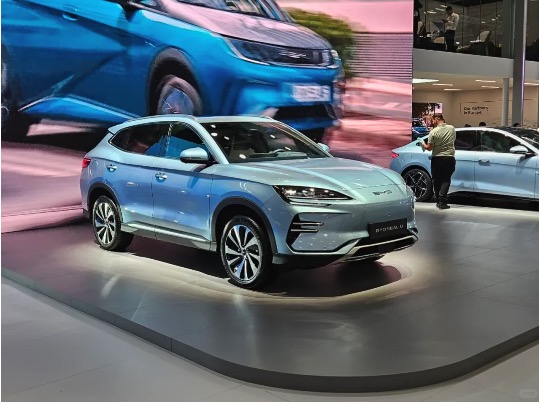According to the statistical data of the China Association of Automobile Manufacturers, the sales volume of automobiles in China in the first quarter of this year was 7.47 million units, a year-on-year increase of 11.2%. Among them, new energy vehicles accounted for 3.075 million units, a year-on-year increase of 47.1%, accounting for 41.2% of the total automobile sales. In addition, the export of complete vehicles maintained growth, and the overseas influence continued to increase. In the first quarter, 1.42 million vehicles were exported, a year-on-year increase of 7.3%, and 441,000 new energy vehicles were exported, a year-on-year increase of 43.9%.
According to the statistical data, among the top ten automobile brands in terms of China’s automobile exports in the first quarter of 2025, self-owned brands showed a polarized situation. Yueda Kia was the only brand to enter the top ten, while Tesla China experienced a significant decline.
Specifically, Chery Automobile firmly ranked first with sales of 252,500 units, but there was a year-on-year decline of 0.1%. Exports have always been Chery’s advantage. As an “old-timer” in China’s automobile exports, Chery has been deeply cultivating overseas markets for many years and has established a complete sales network and production bases. Especially in regions such as Russia, the Middle East, and Latin America, Chery automobiles are deeply loved by local consumers. In addition, in the face of the uncertainty of the global trade environment, Chery has accelerated the promotion of overseas local production, effectively avoiding tariff barriers. At the same time, its new energy models are also popular in Southeast Asia, South America and other places. The sales volume of new energy vehicles in the first quarter was 163,000 units, a year-on-year increase of 171.8%, providing new impetus for export growth.
BYD closely followed, with cumulative exports of 200,700 units in the first quarter, a year-on-year increase of 105.0%, making it the manufacturer with the largest increase among the top ten automakers. Relying on its advantages in core technologies such as batteries, motors, and electronic controls, BYD has launched a series of models that are highly favored by overseas consumers. In addition, BYD has actively promoted local production and self-owned shipping, effectively coping with the high tariff barriers in regions such as Europe and the United States, and further enhancing its competitiveness in overseas markets.
SAIC Motor Passenger Vehicle ranked third with 104,400 units, a year-on-year decline of 17.1%, being the self-owned manufacturer with the largest year-on-year decline in sales volume. The decline in export volume in the first quarter may be related to factors such as increased competition in some markets and supply chain instability. The main brand exported by SAIC Motor Passenger Vehicle is MG. Although the export volume has declined, the MG brand has a good market performance in regions such as Europe, Southeast Asia, and India. SAIC’s deepening reform has achieved remarkable results, with self-owned brands and new energy vehicles becoming the main driving forces for growth. However, SAIC has always been committed to technological innovation and product upgrading, and is expected to regain growth momentum in overseas markets in the future.
Through a series of overseas mergers and acquisitions and strategic cooperation, Geely has rapidly enhanced the international influence of its brand. Its brands such as Volvo and Lynk & Co have performed well in the European market. Especially the Lynk & Co brand, with its unique design, advanced technology, and high-end positioning, has successfully attracted the attention of young consumers in Europe. In addition, Geely is also actively deploying in regions such as Southeast Asia and the Middle East, continuously expanding its overseas market territory. Through local production and marketing, Geely Automobile has better met the needs of local consumers and promoted the growth of its export business.
Changan Automobile exported 98,100 units, a year-on-year increase of 10.1%, maintaining a stable growth trend. Great Wall Motor exported 76,300 units, a year-on-year decline of 7.3%. Great Wall Motor has strong technical advantages and brand awareness in the pickup and SUV segments, and its products are also highly concerned in overseas markets. SAIC-GM-Wuling exported 52,900 units, a year-on-year increase of 7.7%.
The export models of SAIC-GM-Wuling are mainly small and micro cars, and it has a certain market share in regions such as Southeast Asia. However, with the intensification of market competition and changes in the global economic situation, the export business of SAIC-GM-Wuling faces certain pressure.
Jiangsu Yueda Kia exported 38,800 units, a year-on-year increase of 29.1%. As a joint venture brand, although Yueda Kia’s performance in the domestic market is average, domestic production for export has become its new performance growth point. In recent years, with the rise of Chinese self-owned brand automobiles and the rapid development of the global new energy vehicle market, joint venture brands are facing increasing challenges in overseas markets. Jiangsu Yueda Kia needs to accelerate product upgrading and improve its technological level to adapt to market changes and revive its export business.
Tesla China exported 38,100 units, a year-on-year decline of 56.9%. Although Tesla is a globally renowned new energy vehicle brand, its export performance has seriously declined. This may be related to factors such as increased competition in the Chinese new energy vehicle market, policy changes in some overseas markets, and a series of political behaviors of Elon Musk. Outside the top ten list, although the market shares of most manufacturers are not large, they have all achieved significant growth and become new performance growth points. For example, Dongfeng Motor increased by 120.4% year-on-year, Beijing Hyundai increased by 2366.9% year-on-year, and XPeng Motors increased by 370.4% year-on-year.
It is not difficult to see from the ranking that Chinese self-owned brands have increasingly become more advantageous in exports. Among the top ten rankings, except for Tesla and Yueda Kia, the others are all self-owned brands. Among them, Chery Automobile and BYD are far ahead. Especially BYD, with a year-on-year increase of 105.0%, has become the manufacturer with the most growth potential in overseas exports, which is related to BYD’s crazy layout in overseas markets. And joint venture brands including Yueda Kia, Beijing Hyundai, Changan Ford, SAIC-GM, etc., most of them are under sales pressure in the domestic market and have started to export products to overseas markets for sale.
The current achievements of China’s automobile exports are not accidental, but the result of the joint action of multiple factors. From a policy perspective, the state has continuously increased its support for the automobile industry and introduced a series of policy measures to encourage automobile exports, such as optimizing the export tax rebate policy and strengthening overseas market development services, providing a strong guarantee for automobile enterprises to “go global”.
In terms of trade policies, factors such as tariff barriers and trade frictions have a direct impact on automobile exports. In recent years, with the rise of global trade protectionism, some countries and regions have set high tariff barriers and trade restrictions on Chinese automobiles. For example, the EU has imposed countervailing duties on Chinese electric vehicles, which undoubtedly increases the cost and difficulty for Chinese new energy vehicles to enter the European market and to a certain extent suppresses the export growth of related models. However, Chinese automakers are also actively responding by increasing product added value, optimizing the supply chain layout, strengthening local production, etc., to reduce the adverse effects brought by trade policies, and using a diversified product line to hedge the impact of trade barriers and continue to consolidate their competitiveness in the European market.
The international automobile market is extremely competitive. Many internationally renowned automakers have been deploying in the global market for many years and have a profound brand heritage, advanced technology, and a complete sales and service network. Chinese automobile enterprises face huge challenges if they want to stand out in such a market environment. Compared with international automakers, Chinese automobiles once had a large gap in brand awareness, technical level, and product quality. However, in recent years, through continuous increase in R & D investment, improvement of technological innovation capabilities, and optimization of product quality, the competitiveness of Chinese automobiles has been significantly enhanced. Today, Chinese new energy vehicles have taken the lead in the world in fields such as battery technology and intelligent driving and can compete with international automakers.



